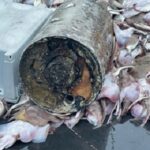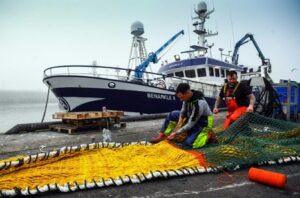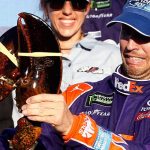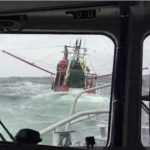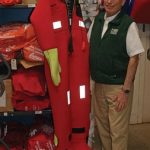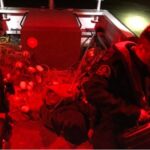Tag Archives: Southwest Fisheries Science Center
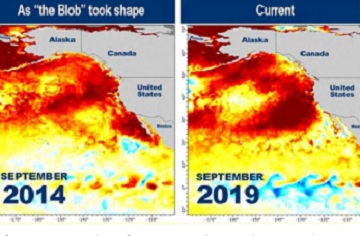
Scientists monitoring new marine heat wave off B.C. coast similar to ‘the Blob’
The swath of unusually warm water stretches roughly from Alaska down to California, according to NOAA in the United States. The marine phenomenon began in the Gulf of Alaska sometime around June 15 and ballooned over the summer.Officials tracking the system said it is already the second-largest experts have seen since 1981 — the first year for which satellite data used to track marine heat waves is available. “Already, on its own, it is one of the most significant events that we’ve seen,” Andrew Leising, a research scientist at the NOAA’s Southwest Fisheries Science Center in La Jolla, Calif., said in a statement Thursday. >click to read< 19:37
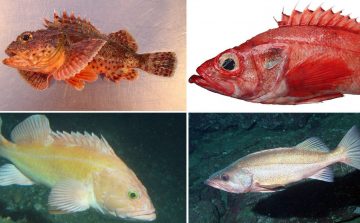
Rockfish make a remarkable recovery off California coast, prompting federal officials to raise catch limits
Locally caught red snapper was once a staple on Southern California menus and a vital part of the state’s fishing industry. But overfishing took its toll, resulting in federal restrictions nearly two decades ago to prevent their extinction. But with stocks rebuilding faster than anticipated, federal officials on Tuesday boosted catch limits by more than 100% for some species of rockfish in a move they said would help revive West Coast bottom trawlers and sportfishing fleets. >click to read<13:15

As the Pacific sardine population keeps dropping, the feds come under scrutiny
On April 8, the Pacific Fishery Management Council – a body of appointed officials that regulates fisheries off the West Coast – will be presented with the draft assessment of the sardine population from roughly southern California to Canada. The news it brings is neither good for fishermen nor the local marine ecosystem: The estimated number of sardines in July 2018 – which dictates policy for the 2018-19 fishing year – is 52,065 metric tons, an approximately 97-percent drop from 2006, the most recent peak. What is in dispute: the accuracy of the population assessment, and how we got here.>click to read<15:30
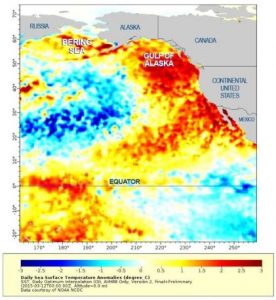
North Pacific Recovering From The Blob, Salmon More Slowly
Ocean conditions off most of the U.S. West Coast are returning roughly to average, after an extreme marine heat wave from about 2014 to 2016 disrupted the California Current Ecosystem and shifted many species beyond their traditional range, according to a new reportfrom NOAA Fisheries’ two marine laboratories on the West Coast. Some warm waters remain off the Pacific Northwest, however. >click to read<07:57
Are big ups and downs normal for forage fish?
 Forage fish stocks have undergone fluctuation swings for hundreds of years, research shows, with at least three species off the US West Coast repeatedly experiencing steep population increases followed by declines long before commercial fishing began. The rise and fall of Pacific sardine, northern anchovy, and Pacific hake off California have been so common that the species were in collapsed condition 29 to 40 percent of the time over the 500-year period from CE 1000 to 1500, according to a new study in Geophysical Research Letters. Using a long time series of fish scales deposited in low-oxygen, offshore sedimentary environments off Southern California, researchers described such collapses as “an intrinsic property of some forage fish populations that should be expected, just as droughts are expected in an arid climate.” Continue reading the article here 07:55
Forage fish stocks have undergone fluctuation swings for hundreds of years, research shows, with at least three species off the US West Coast repeatedly experiencing steep population increases followed by declines long before commercial fishing began. The rise and fall of Pacific sardine, northern anchovy, and Pacific hake off California have been so common that the species were in collapsed condition 29 to 40 percent of the time over the 500-year period from CE 1000 to 1500, according to a new study in Geophysical Research Letters. Using a long time series of fish scales deposited in low-oxygen, offshore sedimentary environments off Southern California, researchers described such collapses as “an intrinsic property of some forage fish populations that should be expected, just as droughts are expected in an arid climate.” Continue reading the article here 07:55
These animals are eating each other! – Genetics lab unravels mystery whale killing at sea
 Little was left of the kill when biologists reached the scene. Frenzied swimming churned the ocean surface. Geysers of bloody water sprayed into the air. Hungry seabirds circled in search of leftovers. But by the time the large research ship arrived at the scene, all biologists could find was a slick of oil from the vanished victim. That, and the unidentified animal’s lungs and heart. Read the rest here 17:01
Little was left of the kill when biologists reached the scene. Frenzied swimming churned the ocean surface. Geysers of bloody water sprayed into the air. Hungry seabirds circled in search of leftovers. But by the time the large research ship arrived at the scene, all biologists could find was a slick of oil from the vanished victim. That, and the unidentified animal’s lungs and heart. Read the rest here 17:01
Squid fishing debuts on North Coast
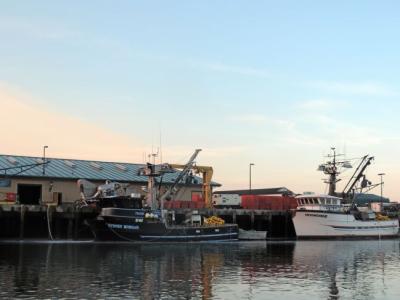 Squid fishing boats docked in Eureka for the first time Thursday, unloading 124,000 pounds of squid at the Fisherman’s Terminal Commercial squid fishermen from Southern California were drawn to the North Coast by following squid that were driven out of their typical habitat by a rise in ocean water temperatures,,, Read the rest here 06:56
Squid fishing boats docked in Eureka for the first time Thursday, unloading 124,000 pounds of squid at the Fisherman’s Terminal Commercial squid fishermen from Southern California were drawn to the North Coast by following squid that were driven out of their typical habitat by a rise in ocean water temperatures,,, Read the rest here 06:56
Trump LaJolla! NOAA’s moves into new fisheries center
 LA JOLLA — The National Oceanic and Atmospheric Administration has started to move into its new Southwest Fisheries Science Center, a $74 million laboratory that will be the agency’s only marine science research facility in Southern California. continued
LA JOLLA — The National Oceanic and Atmospheric Administration has started to move into its new Southwest Fisheries Science Center, a $74 million laboratory that will be the agency’s only marine science research facility in Southern California. continued



































